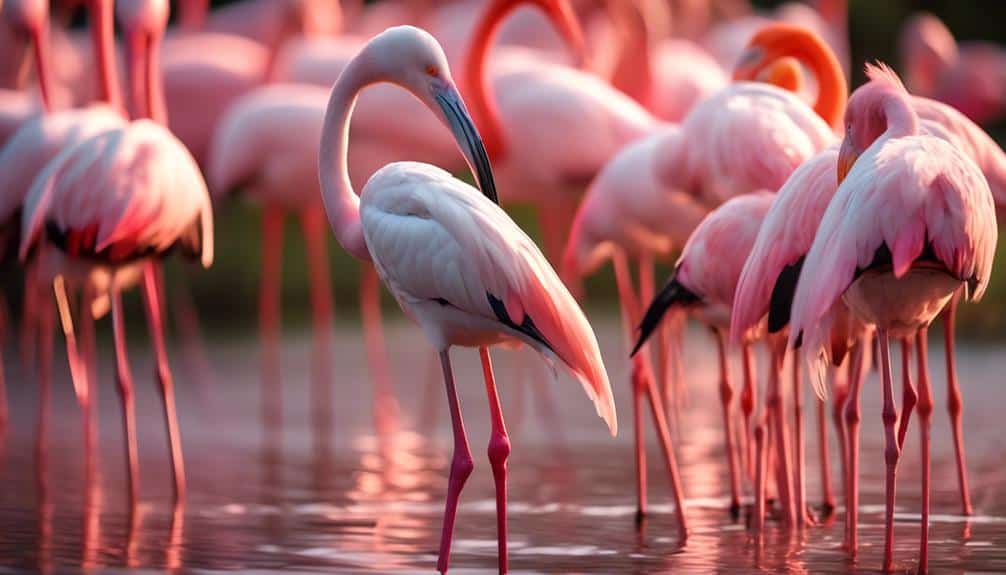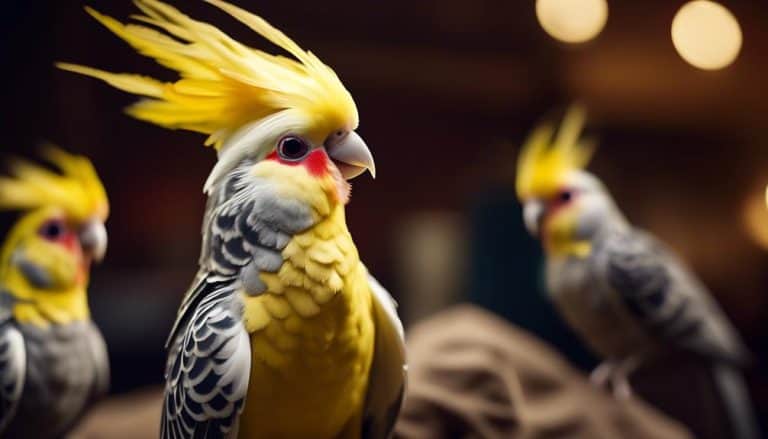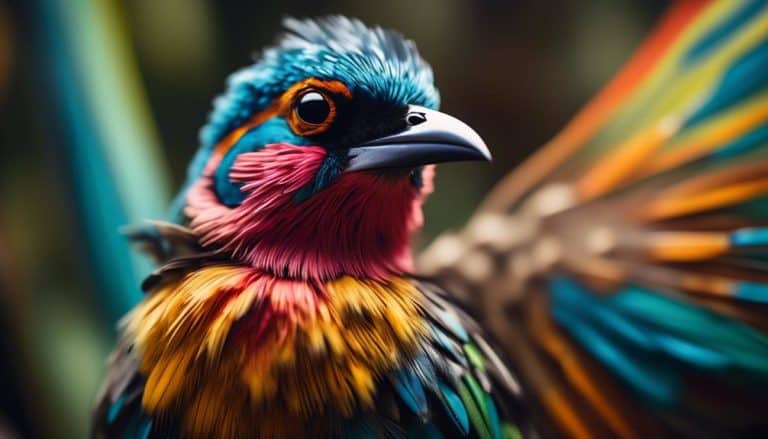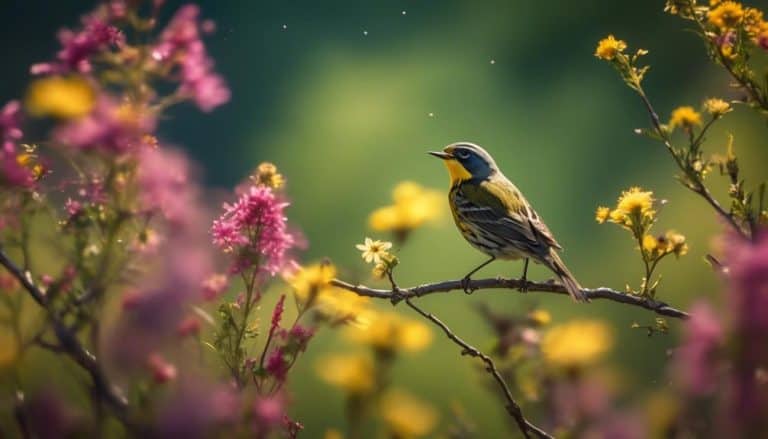As a bird enthusiast, I have always been fascinated by the diverse and unique species that call Florida home. And let me tell you, when it comes to birds with long beaks, Florida is a haven like no other.
From the striking Wood Stork to the elegant American Avocet, these magnificent creatures with their elongated bills are a sight to behold. But what makes them so remarkable?
Join me on a journey through the marshes and wetlands of Florida as we uncover the secrets behind these fascinating birds and the purpose of their extraordinary beaks.
Wood Stork: A Majestic Wetland Resident
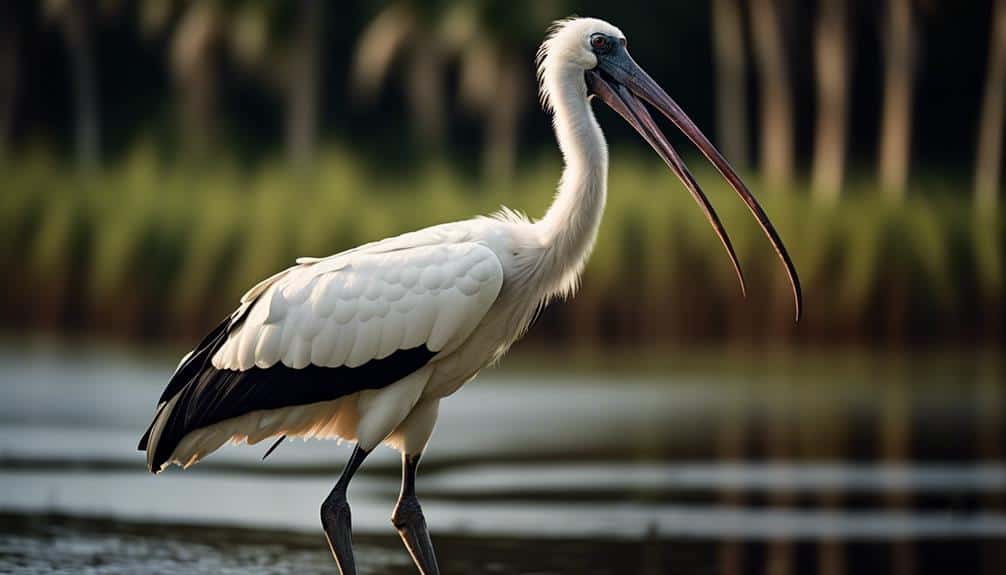
As I observe the wetlands, the majestic presence of the Wood Stork captures my attention with its long beak and graceful demeanor.
The Wood Stork, scientifically known as Mycteria americana, is a large wading bird that can be found in the southeastern United States, particularly in Florida. These birds are predominantly found in wetland habitats, such as marshes, swamps, and flooded fields. They're often seen foraging in shallow waters, using their long beak to catch fish, amphibians, and even small reptiles.
Wood Storks are an important indicator species for the health of wetland ecosystems. Their presence indicates the presence of healthy wetlands, as they rely on these habitats for feeding and nesting. However, due to habitat loss and degradation, the population of Wood Storks has declined significantly over the years.
In response to this decline, various conservation efforts have been put in place to protect and restore their habitats. One such effort is the restoration of wetland areas, both natural and artificial, to provide suitable feeding and nesting grounds for the Wood Storks. Conservation organizations are also working on educating the public about the importance of wetland conservation and the role of Wood Storks in maintaining the balance of these ecosystems.
Roseate Spoonbill: The Pink Beauty of Florida
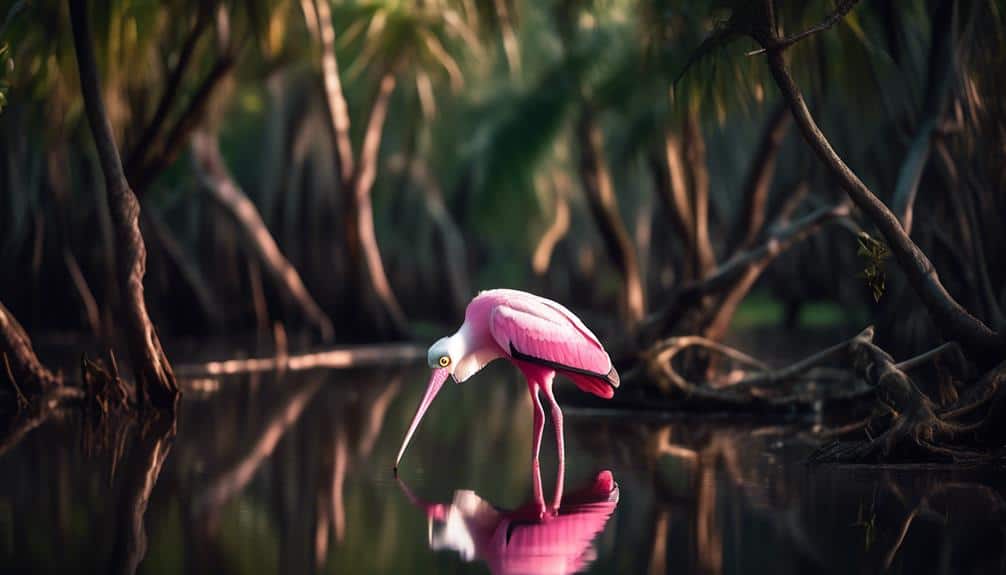
The Roseate Spoonbill, scientifically known as Platalea ajaja, is a stunning avian species that graces the wetlands of Florida with its vibrant pink plumage and distinctive spoon-shaped bill. Standing at around two and a half feet tall, this graceful bird catches the eye with its unique appearance and behavior.
The most striking feature of the Roseate Spoonbill is undoubtedly its pink plumage. The intensity of the pink color can vary depending on the bird's diet, with richer hues observed in those that consume more crustaceans. This pink hue, combined with its elegant silhouette, makes the Roseate Spoonbill a true beauty of the wetlands.
But it's not just its appearance that makes this bird special. The Roseate Spoonbill also possesses unique feeding habits. It wades through shallow waters, sweeping its spoon-shaped bill from side to side. This specialized bill allows the bird to sift through mud and water, capturing small fish, shrimp, and insects. Its bill is incredibly sensitive, allowing it to detect prey even in murky waters.
Observing a flock of Roseate Spoonbills engaged in their feeding behavior is a sight to behold. Their synchronized movements and graceful strides add to the spectacle. These birds truly embody the delicate balance of beauty and functionality in nature.
Great Blue Heron: Tall and Graceful Hunter
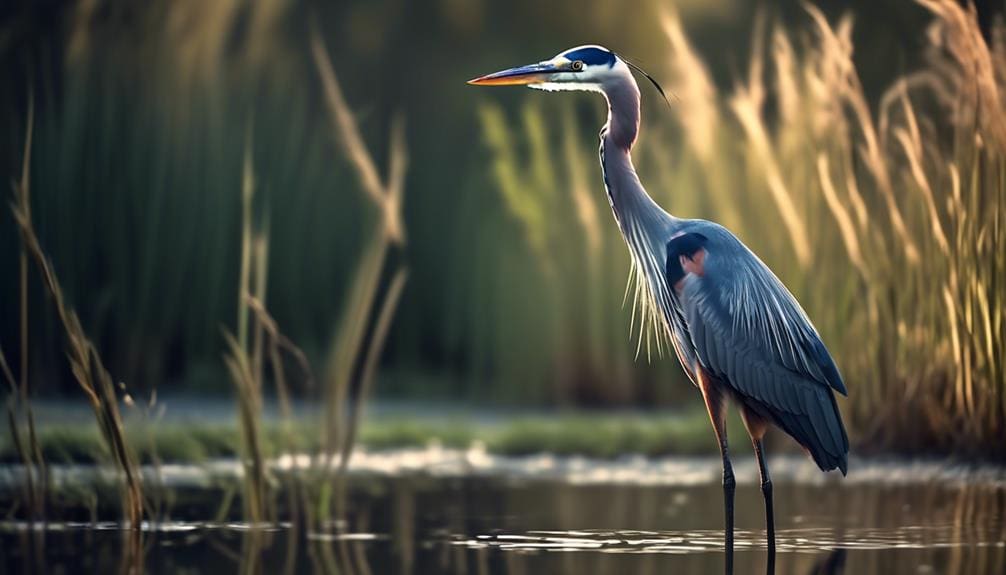
With its towering stature and graceful movements, the Great Blue Heron commands the wetlands as a formidable hunter. Standing at an impressive height of up to 4 feet, this majestic bird possesses a long and slender neck that allows it to scan the surroundings with precision. Its striking blue-gray plumage and long, dagger-like beak make it an unmistakable sight in Florida's marshes and swamps.
The Great Blue Heron has developed unique hunting techniques to ensure its survival in these diverse ecosystems. Its tall and graceful stature allows it to wade through shallow waters, stealthily stalking its prey. With a slow and deliberate approach, it uses its keen eyesight to spot fish, amphibians, and even small mammals swimming beneath the water's surface. Once it spots its target, the heron strikes with lightning speed, extending its long neck and swiftly grabbing its prey with its sharp beak.
To further enhance its hunting capabilities, the Great Blue Heron employs a variety of feeding behaviors. It may use its beak to spear fish or use its powerful bill to grab larger prey. It's also known to stand perfectly still for long periods, patiently waiting for an unsuspecting meal to come within striking distance. This technique, known as 'still-hunting,' showcases the heron's exceptional patience and adaptability.
White Ibis: Florida's Vibrant Beaked Bird
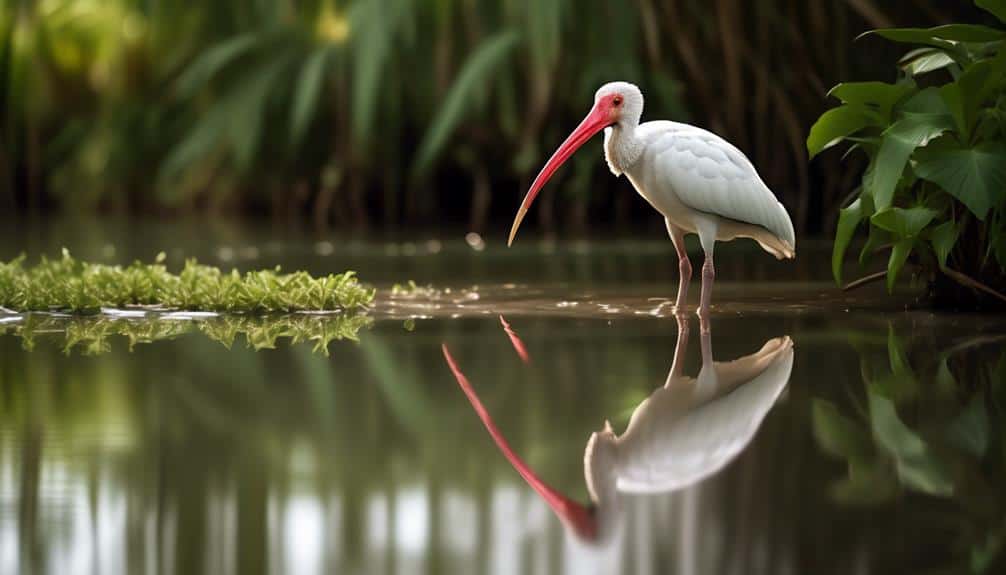
The White Ibis, known for its vibrant beak, adds a splash of color to the Florida landscape. With its long, curved bill that ranges in color from pale pink to bright orange, the White Ibis is a striking sight against the lush greenery of its habitat.
| Habitat | Feeding Habits | Conservation Status |
|---|---|---|
| Wetlands | Probing for prey | Least Concern |
| Marshes | in shallow water | |
| Coastal areas | ||
| Swamps |
The White Ibis can be found in a variety of habitats, including wetlands, marshes, coastal areas, and swamps. It is a highly adaptable bird and is able to thrive in both freshwater and saltwater environments. The ibis prefers areas with shallow water, where it can easily probe the soft mud for its preferred food sources.
When it comes to feeding habits, the White Ibis is primarily a carnivorous bird. It uses its long, curved bill to probe the mud and water, searching for small invertebrates such as worms, insects, and crustaceans. It also feeds on small fish and amphibians. The ibis is known for its feeding technique, which involves repeatedly probing the ground with its bill and then quickly retracting it to catch any prey it may have disturbed.
In terms of conservation status, the White Ibis is currently listed as Least Concern. Its population is stable and it is not facing any significant threats. However, habitat loss and degradation due to human activities, such as urban development and pollution, could potentially impact its future survival. It is important to continue monitoring and protecting the habitats of these vibrant beaked birds to ensure their long-term survival in the Florida landscape.
American Avocet: The Elegance of Long Legs and Beak
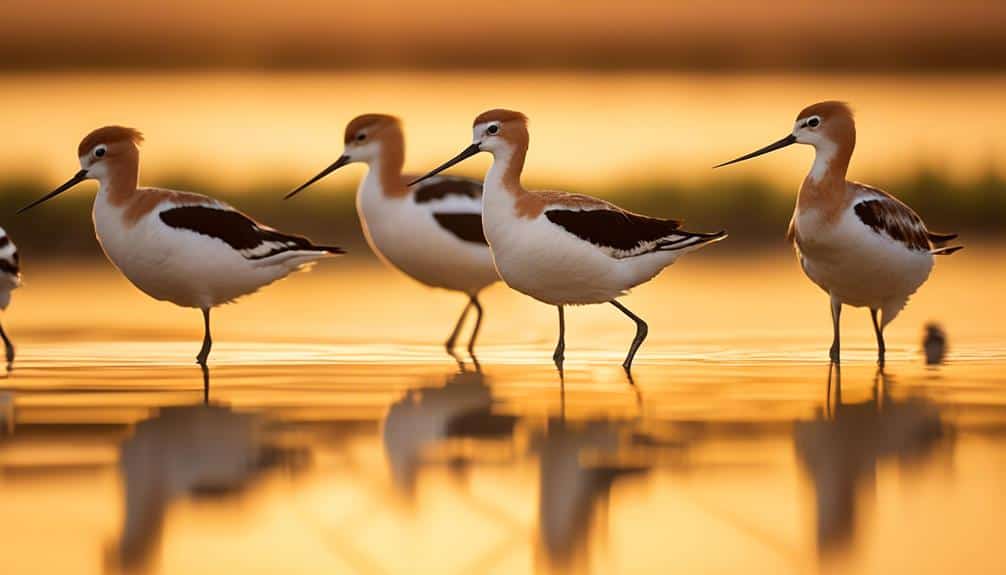
I marveled at the elegance of the American Avocet as it gracefully waded through the shallow waters, its long legs and beak perfectly suited for its foraging technique. The American Avocet, with its distinct black and white plumage and slender, upward-curved bill, is a fascinating bird to observe.
The American Avocet exhibits a unique feeding behavior that sets it apart from other birds. With its long legs, the avocet elegantly walks through the water, gracefully sweeping its bill from side to side. It uses its specialized bill to probe the mud and shallow water for small aquatic invertebrates, such as insects, crustaceans, and mollusks. The avocet's bill isn't only long and slender but also sensitive, allowing it to detect and capture its prey with precision.
In addition to its feeding behavior, the American Avocet is known for its impressive migratory patterns. These birds breed in the northern parts of North America during the summer months and then embark on long journeys to their wintering grounds in the southern United States, Mexico, and even Central America. Along their migration routes, they can be spotted in a variety of wetland habitats, including coastal marshes, mudflats, and shallow lakes.
Frequently Asked Questions
How Do These Birds Adapt to Their Wetland Habitats?
In wetland habitats, birds with long beaks adapt by utilizing their specialized feeding behaviors. These adaptations allow them to efficiently capture prey, such as fish or insects, from the water or mud.
Are These Birds Commonly Found in Other States as Well?
Yes, these birds with long beaks are commonly found in other states as well. Their migration patterns show that they travel to different wetland habitats across the country. Species conservation efforts are crucial to protect their populations.
What Is the Lifespan of These Birds?
The lifespan of these birds can vary depending on factors such as predation and habitat conditions. However, research suggests that long-beaked birds tend to have a lifespan of around 5-10 years on average.
Do They Have Any Predators in Their Natural Habitat?
Do Florida birds with long beaks have any predators in their natural habitat? Yes, they do. These birds have developed various adaptation strategies to protect themselves from predators, such as camouflage, flying in groups, and building nests in hard-to-reach locations.
What Is the Role of These Birds in the Ecosystem?
Florida birds with long beaks play a crucial role in the ecosystem. They act as pollinators, aiding in the reproduction of plants. Additionally, they impact the fish population by feeding on small fish, helping to maintain a balance in aquatic ecosystems.
Conclusion
As I stand here in the wetlands of Florida, marveling at the diverse and captivating bird species with their long beaks, I'm reminded of the intricate balance of nature.
These majestic creatures, such as the Wood Stork, Roseate Spoonbill, Great Blue Heron, White Ibis, and American Avocet, each play a unique role in maintaining the delicate ecosystem.
Their elegant forms and specialized beaks allow them to thrive in this vibrant landscape, showcasing the beauty and complexity of nature's design.

